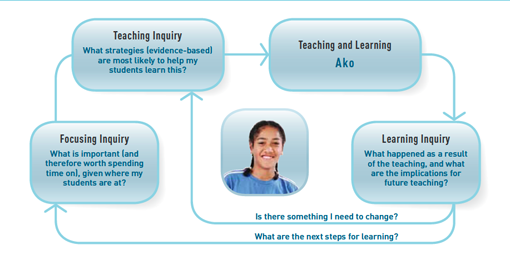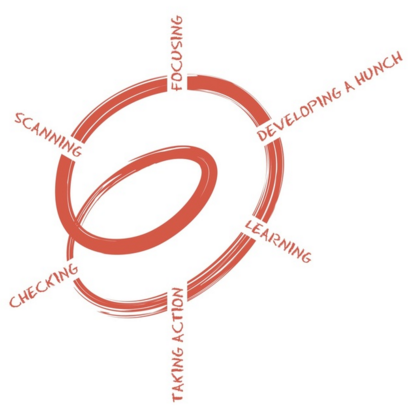Teaching as inquiry cycle
Framework for teaching as inquiry
This NZC-developed framework is cyclical and involves four main components:
Focusing inquiry - Teachers identify the outcomes they want their students to achieve. They consider how their students are doing in relation to those outcomes, and they ask what their students need to learn next in order to achieve them.
Teaching inquiry - Teachers select teaching strategies that will support their students to achieve identified outcomes. This involves asking questions about how well current strategies are working and whether others might be more successful.
Teaching and learning - Putting new strategies into action.
Learning inquiry - Teachers monitor their students' progress towards the identified outcomes and reflect on what this tells them. Teachers use this new information to decide what to do next to ensure continued improvement in student achievement and in their own practice.
Innovation and the spiral of inquiry
Work by Timperley et.al proposes a fresh rethink on the structure of teaching as inquiry.
The model is a spiral, illustrating the constant revisiting and questioning that characterises an effective inquiry. It proposes that inquiry be implemented across a whole school or even a cluster of schools, where change is likely to be more powerful, rather than in single classrooms.
There are no hard and fast rules to the spiral of inquiry. While it is natural to read the steps in a clockwise direction, it is important to remember that these are less like phases, and more like “modes” of thinking.
Once you are familiar and comfortable with the inquiry process, you will find that each part of the spiral framework is something you can dip in and out of as needed.
The parts of the spiral framework include:
- Scanning - Finding out what is happening for all students.
- Focusing - Asking yourself which area you could focus on in order to make the most substantive difference.
- Developing a hunch - Identifying what you can change or do differently in order to improve learning experiences and outcomes for students.
- Learning - Acquiring new knowledge and skills that lead to new actions.
- Taking action - Putting something different in place.
- Checking - Collectively checking to see if you have made enough of a difference.
School story
Spiralling into collaboration at Otago Girls' High School
In this blog Rowan Taigel, Deputy Principal at Otago Girls' High School, shares her knowledge around collaborative spirals of inquiry drawing on her journey leading this framework at her school.





